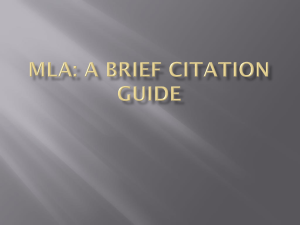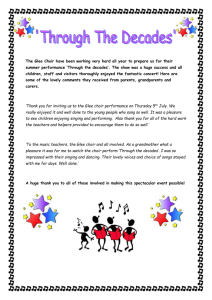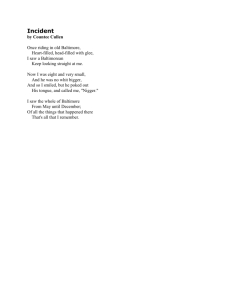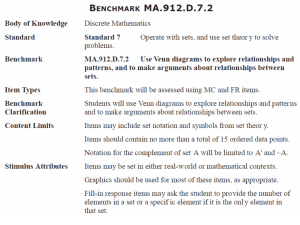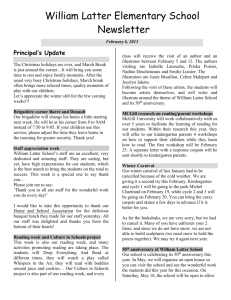Glee Overview 2013
advertisement
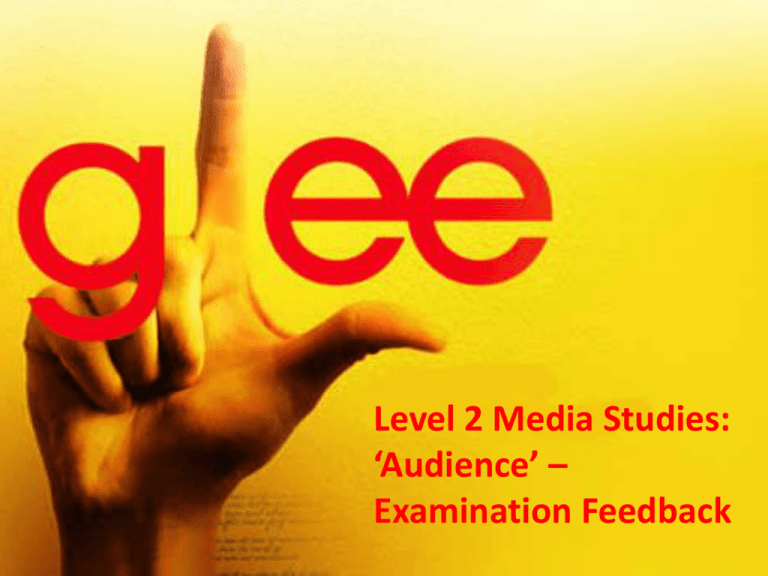
Level 2 Media Studies: ‘Audience’ – Examination Feedback You have a pretty good fundamental knowledge of the media product and its contents. Well done! Our understandings of how these contents appeal to the target audience, our use of specific detail and implications are all still developing. That’s okay. We all have work to do and enough time to do it in. So, let’s get started… Here are a few things most of us could improve upon: • • • • • • • • • • Structure Introductions Describing the media product Describing the target audience Using the key words of the question Including specific evidence of each aspect Describing in depth HOW the aspect connects to the target audience. Explaining implications rather than listing details Incorporating sophisticated class notes Improving expression and vocabulary choice STRUCTURE: 1. Describe the Media Product 2. Describe the Target Audience 3. Describe aspect one – explain how this aspect connects to the target audience 4. Describe aspect two - explain how this aspect connects to the target audience 5. Explain the implications of Glee on the target audience and the entertainment industry as a whole. Our Introductions: • • • outline the scope of the essay: Describe the media product in detail State the we types that be The media product studiedof this aspects year is Glee. Glee is an you’ll American musical comedy-drama series. It was released on American television in 2009 and is now in referring to (eg internal) its fourth season. Glee is set at the fictional William McKinley High School in Lima, It focuses on the high school glee club the New Directions competing on the show • Ohio. Aspects which connect media product to the choir competition circuit, while its members deal with relationships, sexuality and target audience eg. characters, issues, music social issues. The initial main cast encompassed club director and Spanish teacher Will Schuster, cheerleading coach Sue Sylvester, guidance counsellor Emma Pillsbury, • Will's You alsoclubadd some interesting wifecould Terri, and eight members. Producer Ryan Murphy hasmaterial said that he intended the show to be a form of escapism. "There's so much on the air right now such as weekly viewership (approx. 10 million about people with guns, or sci-fi, or lawyers running around. This is a different genre, there's nothing like it on thein air at the networks and cable. Everything's so viewers per week the United States) or how dark in the world right now". Murphy intended to make a family show to appeal to adults as wellseasons as children, with equally alongside many itadult hascharacters beenstarring running (4) orthe teenage leads. Internal appeal techniques used in this media product to connect to thewhere/when target audience are theit usescreens of characters in and NZ. ensemble cast, music and issues. ( Wednesday 7:30 on Four) Paragraph 2:Define the target audience: • 10-39 year old males and females • As television NOT YOUNG HOPEFULS! (Thispurpose is how they are programmes are created for a commercial they are not valued for their artistic value but rather for their sale-ability or viability in terms of grouped or identified) generating ratings. To achieve these ratings media products are often designed with audience in mind. The more a media group, producer canaknow about an audience, • athetarget And within that target special better that audience can be targeted. Advertisers and media producers believe thatemphasis consumers can beupon sorted into groups with common characteristics. The way teenagers (particularly audiences are identified and grouped according to isolating characteristics is known female),This teachers, young couples andincome, young as demographics. includes aspects such as age, gender, ethnicity, occupation, religious views and education. The target audience for Glee is young and music general. menparents and women, between the ages oflovers 10 and 39. in More specifically the show is towards high school students, teachers, young audience couples or families, and music • aimed Mention that the intended was lovers. This can be seen by the way Glee uses humour, characters (ensemble cast), special guests, music, and also in to the types of issuesaraised in each episode. This and extremely large ensure wide fan base target audience has changed over time as it has become evident that the show is secure high Ratings effect largely more popular withratings. the teen age group rather than adults. profit. BODY PARAGRAPHS: • Always begin with a topic sentence and key words that reveal the scope of your paragraph • e.g. ‘The first aspect used to connect the Glee to its target audience is the internal appeal of Characters and ensemble cast… • Then introduce them: • e.g. Rachel Berry is a talented, driven 15 year old (?), who in her eyes is destined for fame, and somewhat of a social outcast. • Then go on to describe the characters in specific depth. This is vital. • Refer to the specific episode where they did something typical to their behaviour eg Rachel acts like a prima donna in Episode 1 when…, Puck bullies someone in Episode…because…, Will gives up on his dreams when… • THEN…Link that character to the target audience and say why they appeal to that audience. ISSUES: When discussing Issues, make sure you are not just describing how those issues are dealt with on the show (go into specific detail- reference events in episodes), but link them to the audience in depth. For example, the audience will identify with issues/characters and tune in to see how they deal with their issues for possibly: ~ reassurance that the issue can be dealt with ~ security in knowing that not only they are facing that issue ~ implied advice about how to deal with that issue themselves Arguably, shows like Glee are raising awareness of these issues and presenting them in a manner which allows the audience to see these people as ‘normal’ or similar to themselves. This can lead to acceptance and tolerance of people in their lives. Music: Discuss the use of specific songs- their titles, artists, genres, dates released, sources (eg the name of the show/film/musical they’re from) – and the part of the audience they are targeted towards/ why the audience would respond to them. Discuss why they have been used at that particular point, e.g. to reveal character/ thematically/ narratively. Discuss the television show’s commitment to introducing its audience to music, new and old. Introduce the implication of how Glee has become a successful marketing platform for music companies wanting to launch new music. And how Glee has successfully sold millions of their own cover albums, making Glee an important player in the music industry. Implications: Programming renewalInto its 4th Season First season extended from 13 to 24(?) episodes based on its success Attraction of celebrity guests Identity forming - Gleeks (leading to expansion of franchise into different media) Merchandising to affirm identity (also free advertising/promotion Fandoms on Tumblr, Groups on Facebook – allow producers personal access to fans The Glee Project giving fans an opportunity to be part of the show Downloads on iTunes (both of originals and Glee versions of songs) DVD sets and Glee Concert Movie Level 2 Media Studies: ‘Audience’ – REVISION KEY POINTS ESSAY STRUCTURE 1. 2. 3. 4. 5. Describe the Media Product Describe the Target Audience Describe aspect one – explain how this aspect connects to the target audience Describe aspect two - explain how this aspect connects to the target audience Explain the implications of Glee on the target audience and the entertainment industry as a whole. DESCRIBE THE MEDIA PRODUCT • Glee is an American musical comedy-drama series. • It was released on American television in 2009 and is now in its fourth season. • Glee is set at the fictional William McKinley High School in Lima, Ohio. • It focuses on the high school glee club New Directions competing on the show choir competition circuit, while its members deal with relationships, sexuality and social issues. • Producer Ryan Murphy intended to make a family show to appeal to adults as well as children. DESCRIBE THE TARGET AUDIENCE • As television programmes are created for a commercial purpose they are not valued for their artistic value but rather for their saleability or viability in terms of generating ratings. • To achieve these ratings media products are often designed with a target audience in mind. The more a media producer can know about an audience, the better that audience can be targeted. • The target audience for Glee is young men and women, between the ages of 10 and 39. • More specifically the show is aimed towards high school students, teachers, young couples or families, and music lovers. • This can be seen by the way Glee uses internal appeal techniques such as humour, characters (ensemble cast), special guests, music, and also in the types of issues raised in each episode. • Glee’s target audience has changed over time as it has become evident that the show is largely more popular with the teen age group rather than adults. • It is important that media products reflect their target audience in some manner in order for that target audience to be able to identify with, enjoy and find benefit from that media product. ASPECT 1: CHARACTERS • Glee is a prime example of how an ensemble cast is used to build a relationship with its target audience. This kind of casting is popular in television series because it allows flexibility for writers to focus on different characters and issues in different episodes. • A range of characters is also important as it gives audiences a number of characters and personalities to identify with and relate to in some way. • These characters are important as audiences will recognise aspects of their own personalities within these characters. Audiences can also then identify with some of the experiences and struggles those characters face. • This forms an emotional connection between the audience and the media product. Once this connection is formed it is likely the viewer will continue watching the show as they have become emotionally invested in the fate of the characters they have best identified with. • Glee has a stereotypical demographic of the students in high schools and does a good job showcasing main characters from different race/ethnic, health, sexual orientation, and disability backgrounds. Glee has a diverse cast which contains stereotyped characters such as the gay, geek, popular cheerleader, jock and bad boy rebel. Kurt, Rachel, Quinn and Finn are examples of these stereotypes. ASPECT 2: MUSIC • • • • • • • • • Writer Ryan Murphy wanted to maintain a balance between chart hits and show tunes: “I want there to be something for everybody in every episode”. In using a range of songs from different decades and genres the show ensures they will appeal to a wide range of people, generate high ratings and be profitable. In later seasons the music chosen changed to include a greater number of chart hits in order to further appeal to a younger demographic. Many musicians saw the show as an opportunity to revive their careers and sales “They loved that this show was about optimism and young kids, for the most part, reinterpreting their classics for a new audience." Composer and musician Billy Joel offered many of his songs for use on the show, and other artists have offered use of their songs for free. A series of Glee soundtrack albums have been released through Columbia Records. Songs featured on the show are available for digital download through iTunes up to two weeks before new episodes air, and through other digital outlets and mobile carriers a week later. For the second season, the creators were offered listens of upcoming songs in advance by publishers and record labels, with production occurring even before song rights are cleared. Glee has become a successful marketing platform for music companies wanting to launch new music. It has successfully sold millions of their own cover albums, making Glee an important player in the music industry. ASPECT 3: ISSUES • By dealing with issues and interests in the lives of their target audiences, media producers reflect their attitudes, needs, wants, and beliefs. • This will encourage the target to tune into the programme on a regular basis, as they see a ‘reflection’ of their own lives and experiences on-screen. • The audience will identify with issues the characters face and tune in to see how they deal with their issues, possibly for reassurance that the issue can be dealt with, security in knowing that not only they are facing that issue or to gain advice about how to deal with that issue themselves. • Issues in Glee also change from season to season to reflect the aging of the target audience and the type of issues they face at different stages of their lives. The characters themselves age at the same rate as the target audience. • Issues range from relationship problems, bullying, teen pregnancy, suicide, identity and acceptance to finding a place in the world, relationship breakdowns, cheating, growing apart or being left behind when friends/partners leave school. IMPLICATIONS • • • • • • • • • Media products such as ‘Glee’ have the ability of shaping the attitudes, beliefs and behaviours of their target audience. The television programme ‘Glee’ has created many implications for the audience and also the music industry and media industry as a whole. ‘Glee’ clubs have been created in schools in New Zealand, Songs which feature on ‘Glee’ have risen in charts and increased in sales. Rihanna’s “Take a Bow” increased in sales by 189% after featuring on the show. Glee has evolved from being simply a form of entertainment to an avenue for music promotion and advertising. Music which appears on the show is almost guaranteed to be successful. Musicians are now using Glee to promote new unreleased singles to a mass audience. Glee is helping bands remain successful and reach a widespread audience. Glee has become a source of identification for its audience. Fans of ‘Glee’ have created a portmanteau of the words “glee” and “geek.” They refer to themselves as “gleeks.” Glee has opened up the television and entertainment industry up to a new genre of musical-drama. It has made this genre acceptable and popular but also safe for producers as there is now an established audience. Glee has inspired the creation of other musical television dramas such as SMASH – based on a the production of a musical about Marilyn Munroe. Glee has also inspired the creation of musical films such as recently released Pitch Perfect about an all female a capella group. This is clearly aimed at the high school musical, Glee generation. Season 4: • Plot: Rachel has moved from Lima to New York in order to attend NYADA. Kurt is living with Rachel and working at the New York Vogue office. • Finn has joined the army but is discharged after accidentally firing a weapon into his own leg. When Finn visits Rachel in New York, he feels as if he has no place in the big apple, as well as questioning Rachel's budding relationship with Brody. • At the same time, Blaine travels to New York to try to get his relationship with Kurt back on track. • Back in Ohio, Santana surprises Brittany by visiting her, and they are faced with the decision of breaking up due to the strains of having a long distance relationship. Also, Will and Emma start to quarrel over Will's new job in Washington D.C. Season 4: Changes in Character • New characters have been introduced to replace those characters that have left. The episodes shift between New York and Lima, Ohio. This is largely to retain the original target audience but also attract new viewers. This is to replace the previous target audience as they grow up and stop following the show. • New characters: Wade /‘Unique’, Marley, Jake, Kitty Season 4: Changes in Special Guests • • • • Kate Hudson Whoopi Goldberg Sarah Jessica Parker Demi Lovato Season 4: Changes in Issues • “What am I going to do with my life? I don't have my girl. I don't have a job. I don't have a place in this world.” • Brody: “I had a girlfriend back home when I started NYADA, We lasted six weeks.” Rachel: “That's not gonna happen to us! I'm not turning my back on him.” • “I went over to his place because I felt like Kurt was moving on with his life and I wasn't a part of it.” • “I feel more than I know how to express. I’m heartbroken. To be honest, I don’t even know how we’re all supposed to move forward.” • The issues characters face reflect the stages they are at in life. Just as their audience has aged and experience different issues or challenges, so do the characters in Glee. Many of the characters have to deal with concerns about their future and leaving people behind once they have left highschool. Season 4: Changes in Music • • • • • • Barely Breathing - Duncan Sheik 1996 Give your Heart a break – Demi Lovato 2012 Teenage Dream – Katie Perry 2010 Don’t Speak – No Doubt 1996 Mine – Taylor Swift 2010 The Scientist – Coldplay 2002 • Episodes from later seasons contain increasingly more chart songs. This reflects the changing target audience – the majority of people now watching the show are teenagers rather than adults. Cory Monteith – ‘The Quarterback’ • "The Quarterback" is the third episode of the fifth season of the American musical television series Glee. It first aired in the United States on October 10, 2013. The episode features the death of character Finn Hudson, and a tribute to Finn and to actor Cory Monteith, who died on July 13, 2013. • Upon its initial airing, this episode was viewed by 7.40 million American viewers and garnered a 2.9 rating in the 18–49 age group. The total viewership and ratings for this episode were up significantly from the previous episode. It was the show's highest rating since September 20, 2012. • All profits made from selling the music in this episode were donated to one of Cory's favourite charities: Project Limelight. • Ryan admits producing the episode, which airs in Australia on Eleven on Friday, October 11, was a big responsibility – not only in honouring Cory’s memory, but in reaching out to teens who may never have lost someone.

